While monovision contact lenses (CLs) for presbyopia occupied the throne for a long time, this has shifted over the last couple of decades as more disposable multifocals have entered the market, making it gradually more apparent that patients prefer this modality. While recent research on this trend is limited, a 2006 study that compared Bausch + Lomb’s SofLens multifocal to a SofLens 59 monovision fit reported that 76% of patients preferred the multifocal.1
At first, the lack of multifocal toric soft CLs (SCLs) on the market left astigmats with limited options. These patients could be offered rigid gas-permeable lenses (GPs). However, the absence of an immediate on-eye experience, the upfront costs, risk of CL discomfort, complexity of fitting multifocal GPs and the danger of corneal molding with the earlier aspheric designs were, and to some degree still are, significant barriers.2
In 2007, astigmatic patients were finally presented with a solution when CooperVision launched the first monthly multifocal toric lens (Proclear). Trial lens kits were not practical, as this lens comes in a large range of parameters. Therefore, trial lenses had to be ordered to allow for a follow-up visit where several lens combinations could be tried.3 After B+L’s Ultra multifocal for astigmatism became available in 2019 and practitioners were provided with trial lens sets, presbyopic astigmats could finally undergo an immediate on-eye experience.4
Since B+L launched the first soft multifocal lens in 1984, there are now over 60 different brands made by 15 companies.5,6 These brands employ technologies that include aspheric optics, concentric circle designs, translating lenses or a combination of these features.7
These evolving technologies have allowed for a gradual increase in the number of presbyopes fit into CLs. Between 2003 and 2019, the percentage of all CL fittings that was for presbyopes rose from 20% to 35%, and between 2005 and 2020, the percentage of presbyopes that were fit into multifocal lenses compared to single-vision lenses doubled from 25% to 50%.6,7 The increasing demand for this service makes it more important than ever for clinicians to be knowledgeable about the many multifocal lens options that exist to make the most appropriate selection for each patient and improve satisfaction of wear.
While numerous types of multifocal lenses exist, such as corneal GP, scleral and hybrid lenses, this article will focus specifically on SCL options for patients with presbyopia and/or astigmatism. These lenses are also more common than rigid designs; last year in the US, soft multifocal lenses made up more multifocal lens fittings (12%) than rigid lens designs, which made up only 1%.8
Below, we catalog in alphabetical order the wide selection of these lenses available today. While the four largest CL companies (Alcon, B+L, CooperVision and Johnson & Johnson Vision Care) dominate the multifocal SCL market, there are many others that have innovative designs worth considering for your patients.
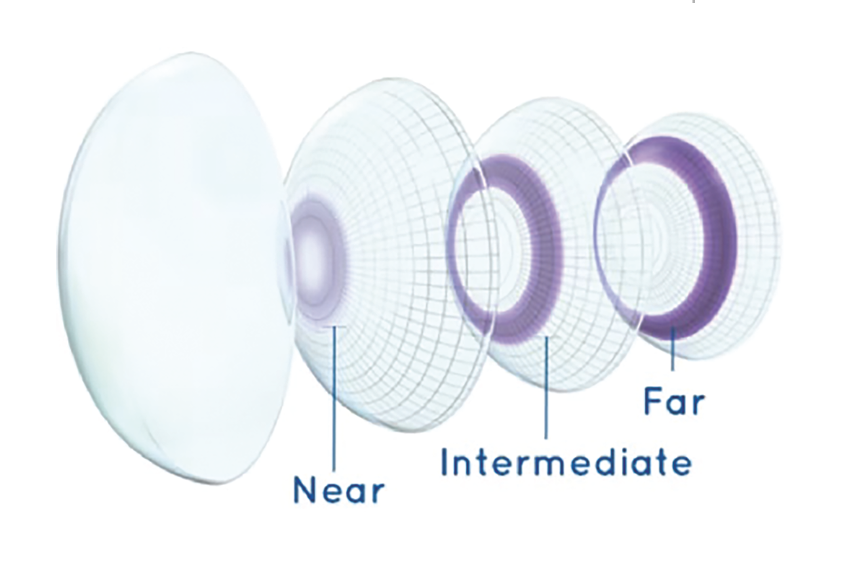 |
|
Fig. 1. Alcon’s “precision profile design” (in Dailies Total1, Dailies AquaComfort Plus and Air Optix plus HydraGlyde multifocal lenses) provides additional minus power at the optic zone edge to optimize near vision without compromising distance acuity. Photo: Alcon. Click image to enlarge. |
Alcon Laboratories
Following the Air Optix Aqua multifocal launch in 2009 and Air Optix plus HydraGlyde multifocal in 2018, Alcon has become a leader in this market segment. All its lenses come in three center-near aspheric bifocal adds.
• Air Optix plus HydraGlyde Multifocal. This silicone hydrogel (lotrafilcon B) monthly lens employs what the company calls a multifocal “precision profile” that combines a bi-aspheric surface, adaptive minus power profile and center-near design. The benefit to the patient is that the aspheric front-surface enhances overall image quality, the aspheric back-surface allows better lens centration, and the adaptive minus-power profile provides additional minus power at the edge of the optic zone, which allows “pushing plus” so that near vision can be improved without compromising distance acuity (Figure 1).
An advantages of this lens is that it’s available in three add powers, allowing precise balance of the near and distance visual acuity. It may also be a good option for the budget-conscious CL wearer.
• Dailies AquaComfort Plus Multifocal. This daily disposable lens comes in a HEMA material (nelfilcon A) and employs the same precision profile design as in the Air Optix plus HydraGlyde multifocal. This guarantees equivalent visual performance of all of Alcon’s multifocals and allows certain patients to transition easily between the different options, such as those who prefer occasional wear or the convenience of a daily disposable lens, or those who have become CL-intolerant due to allergies or deposits.9
Dailies AquaComfort Plus multifocal is suitable for presbyopes desiring a hypoallergenic, affordable daily lens.
• Dailies Total1 Multifocal. Dailies Total1 (delefilcon A) CLs incorporate “water gradient technology,” combining a high Dk with a lens surface that is nearly 100% water.10 Due to its hydrating properties, this lens is an excellent choice for patients with dry eye or extensive digital device use.
• Total30 Multifocal. Total30 multifocal (lehfilcon A) is a one-month replacement high Dk soft lens that also employs “water gradient technology” as well as “celligent technology,” which the company says provides long-lasting hydration and resistance to lens deposits. Launched just last month, with the same multifocal design as other Alcon lenses, this lens is a top choice for patients that prefer a high-performing monthly replacement multifocal.11
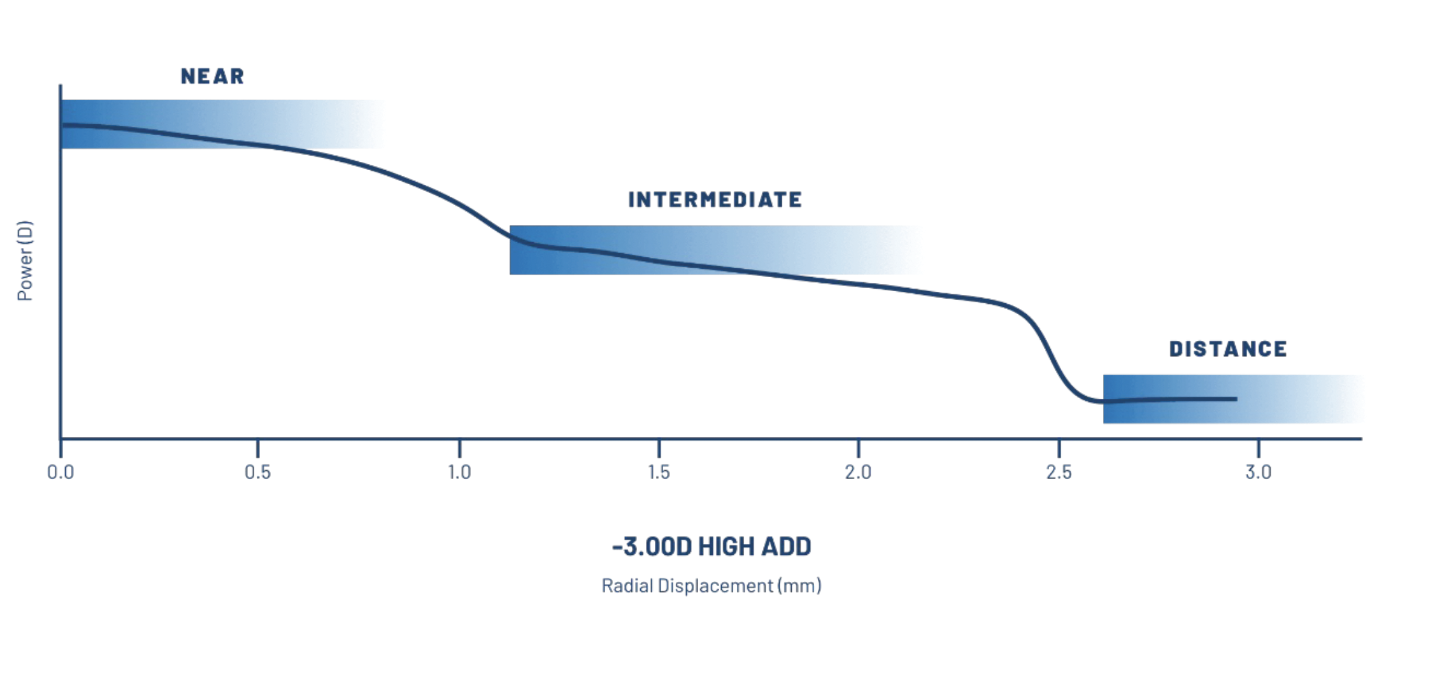 |
Fig. 2. This graph shows B+L’s “3-zone progressive design” add transition for a -3.00D high add. This feature is included in the company’s PureVision 2 for presbyopia and Ultra multifocals.19 Photo: B+L. Click image to enlarge. |
Bausch + Lomb
While the smallest of the “big four,” this company has long been a leader in innovation and a consistent player in the multifocal segment. Since B+L made the first SCL multifocal, it has had many successful multifocal brands, including the SofLens multifocal, PureVision multifocal, PureVision 2 for presbyopia, Ultra for presbyopia, Biotrue OneDay for presbyopia, Infuse multifocal, Revive multifocal and Astera multifocal. The Ultra, Revive and Astera multifocal options are offered in toric versions as well.
Let’s break down the current multifocal SCL options in B+L’s portfolio:
• Astera Multifocal and Multifocal Toric. This highly customizable frequent replacement lens was developed by Alden Optical, which was acquired by B+L in 2016. This center-near lens is made of a lower-Dk HEMA derivative (hioxifilcon D) that comes in a large range of powers (-30.00 to +30.00D), base curves (6.5 to 9.7), diameters (10mm to 16mm) and three adds (low, medium, high) with the highest add of at least +2.50D.12 The C2 multifocal design consists of a large-intermediate and a near zone that can be adjusted from 1.8mm to 3mm to accommodate the patient’s pupil size or work conditions. The toric multifocal lens provides around-the-clock cylinder powers in 1° increments from -0.50D to -10.00D in 0.25D steps using a precise dual slab-off process (“dual elliptical stabilization system,” as the company calls it) that intends to provide superior rotational stability.5,13,14 This lens should be on your list of options for patients with high refractive errors who prefer multifocal soft CLs.
• PureVision Multifocal and PureVision 2 for Presbyopia. While both brands use the same material (balafilcon A) with a low or high center-near aspheric multifocal design, the PureVision multifocal, launched in 2005, lacks some of the unique design features of the newer PureVision 2 for Presbyopia, which came out in 2013. The latter lens is thinner, significantly increasing its Dk, the edge bevel is flattened and, most importantly, the center-near aspheric optics have been improved to contain three progressive zones for distance, intermediate and near instead of only a near and distance zone present in the original PureVision multifocal (a feature that B+L calls the “3-zone progressive design;” Figure 2).15 This makes the PureVision 2 more comfortable as well as provide better near acuity.12
• Revive Multifocal and Multifocal Toric. Launched in the fall of 2022, Revive is the newest addition to B+L’s portfolio, made of the same material and offering the same customizable parameters as the Astera lenses. Unlike the Astera, the Revive lens also comes in a custom sphere and toric lens without the multifocal.5,13,16
• SofLens Multifocal. This low water content, non-ionic HEMA (polymacon) two-week replacement lens was launched in 2002 and comes in two base curves, two bifocal adds and a center-near aspheric design. There are still some loyal SofLens multifocal wearers, as this is one of the few two-week replacement HEMA lenses available with a proven favorable depositing profile.17
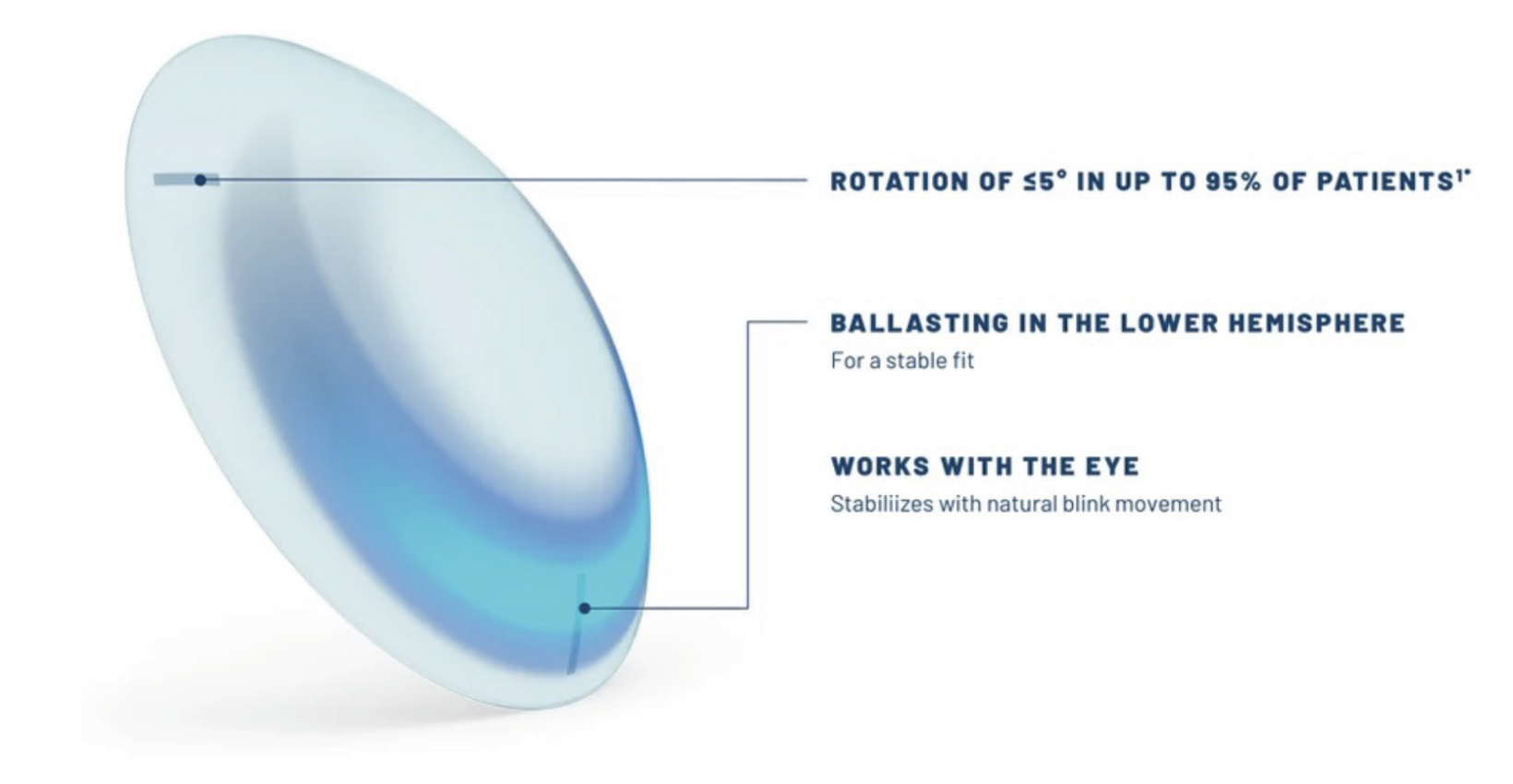 |
|
Fig. 3. B+L’s “OpticAlign” design, featured in Ultra multifocal for astigmatism, guarantees a rotation of 5° or less for 95% of patients. Photo: B+L. Click image to enlarge. |
• Ultra for Presbyopia and Ultra Multifocal for Astigmatism. The Ultra is made from a new silicone hydrogel material (samfilcon A) that employs what B+L calls “MoistureSeal technology”—a curing process that seals the lubricant polyvinyl pyrrolidone (PVP) into the contact lens, allowing a fourfold increase in PVP content. The result is an increase in Dk and water content compared to the PureVision 2 (46% and 163Dk/t compared to 36% and 130Dk/t).
The Ultra for presbyopia has been on the market since 2016 using the same 3-zone progressive design as the PureVision 2 but with added aspheric optics for reduced halos and glare.18 B+L’s research accounted for pupil diameter, corneal curvature, refractive error, axial length, higher-order aberrations and accommodation at multiple distances to produce a lens that maximizes real-world far, near and intermediate visual acuity.15
The Ultra multifocal for astigmatism employs the same design as the Ultra for presbyopia and is the only lens in this category that comes with a fitting set of cylinder powers up to -2.25D for immediate in-office fitting. A -2.75D cyl power can also be ordered from B+L. The toric design, coined “OpticAlign” by developers, is made up of a combination of inferior prism ballast and two superior temporal and nasal thin zones for a reported rotation of 5° or less for 95% of patients (Figure 3).19
The Ultra might be a convenient choice for astigmatic presbyopes who prefer multifocal soft CL correction.
• Biotrue OneDay for Presbyopia. Biotrue (nesofilcon A), along with the Infuse and Ultra brands, contain aspheric optics optimized for each individual lens power. This lens again features the company’s 3-zone progressive design, a water content of 78%—matching that of the cornea—and PVP. It also contains poloxamer 407—a polymer that rises to the lens surface while the lens is curing. Together, these features help to provide hydration and high-quality vision that has been shown in company trials to last throughout the day for most wearers. Biotrue OneDay also absorbs UV light.9,20 This lens may benefit presbyopes who desire sharp vision in a daily disposable modality.
• Infuse Multifocal. Infuse is a next-generation daily disposable silicone hydrogel material (kalifilcon A) that combines a high moisture content (55%), high oxygen transmission (134Dk/t), a low modulus (0.5MPa) and “probalance technology,” as B+L puts it, which means the lens consists of the osmoprotectants erythritol and glycerin, the electrolyte potassium and moisturizers poloxamine 1107 and poloxamer 181. The “probalance” design feature was developed based on data from the TFOS DEWS II report that showed an important role for these molecules in dry eye.21 Infuse Multifocal also uses the 3-zone progressive design and absorbs UV light like Biotrue OneDay.22 This extensive array of features makes this a premium multifocal suited to patients with allergies, dry eye, long wearing hours and extensive near tasks.
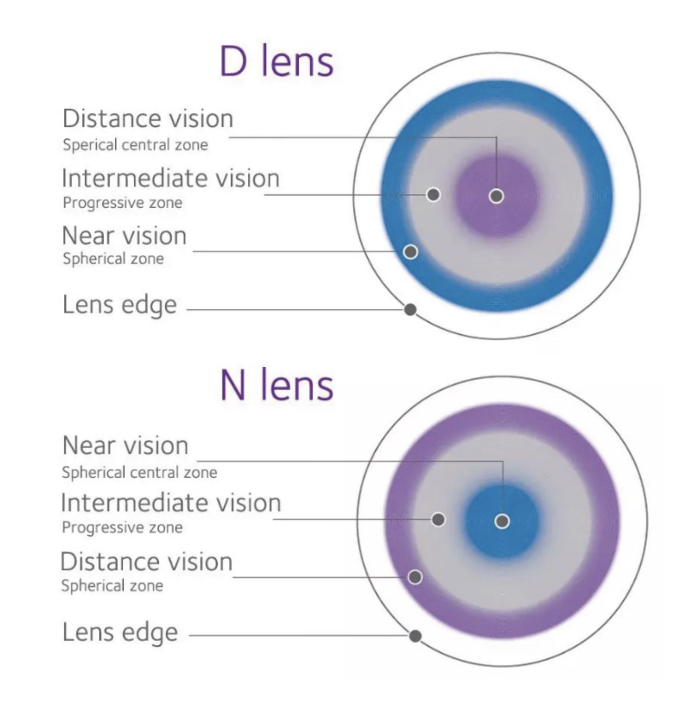 |
Fig. 4. CooperVision’s “balanced progressive technology” featured in Biofinity and Proclear multifocal SCLs provides a near and distance spherical zone separated by a large progressive intermediate zone.26 Photo: CooperVision. Click image to enlarge. |
CooperVision
When it comes to variety and the widest range of parameters, CooperVision takes the prize in the multifocal SCL market. The company makes several brands that come in a center-near (“N”) and center-distance (“D”) multifocal design, which provides “modified monovision” fitting opportunities by optimizing the dominant eye with the D lens for distance and the non-dominant eye with the N lens for near vision.
The following multifocal SCLs are currently offered by CooperVision:
• Biofinity Multifocal and Biofinity Toric Multifocal. Biofinity (comfilcon A) is a monthly, breathable (160Dk/t) silicone hydrogel lens made with the company’s “aquaform” design to lock in moisture and increase comfort.23 Biofinity multifocal and multifocal toric lenses come in a wide range of sphere powers and in four add powers (+1.00D to +2.50D) in a center-near and distance-near lens. The company’s “balanced progressive” feature allows for a near and distance spherical zone separated by a large progressive intermediate zone, giving clinicians the option to choose between an N or D lens (Figure 4).
The Biofinity Toric Multifocal comes in a -0.75D to -5.75D cylinder range in 5° steps around the clock. CooperVision’s torics are known for their rotational stability, using something called “optimized toric lens geometry” consisting of a wide ballast band, uniform lens thickness across the horizontal path, a larger toric optical zone and a soft, uniform surface for more stable vision.3
CooperVision provides fitting sets for the Biofinity multifocal that allow an immediate on-eye experience and the opportunity to gauge the ability to adjust to modified monovision with a D lens in one and an N lens in the other eye. This makes the Biofinity a suitable lens choice for patients with presbyopia progression that can accept modified monovision and cannot achieve distance vision in adequate focus with their habitual lenses.
• Clariti 1 Day Multifocal. With one study reporting 75% of daily disposable CL wearers nap in their lenses, Clariti 1 Day multifocal is a more breathable silicone hydrogel (somofilcon A, 86Dk/t) alternative to other less oxygen-permeable daily disposable lenses.24 The lens comes in two center-near progressive adds and filters UV light.25 Patients requiring a higher Dk lens may be offered this option.
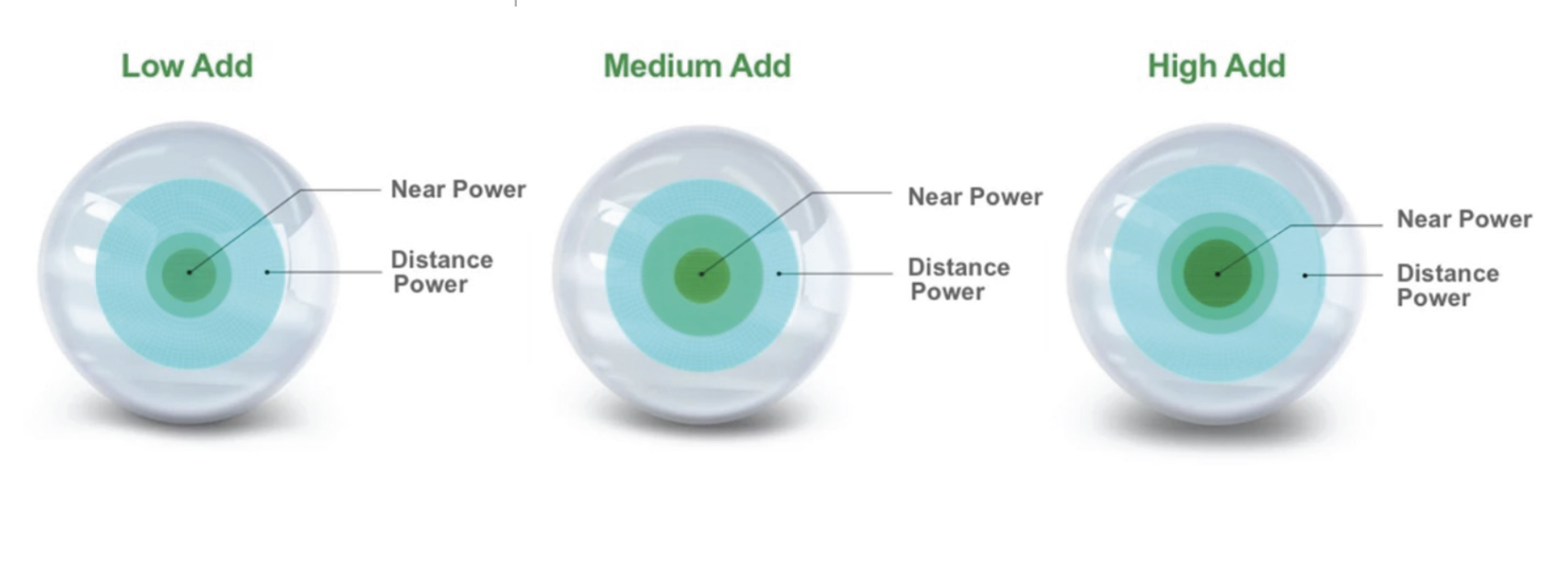 |
Fig. 5. This image illustrates the “binocular progressive system” in CooperVision’s MyDay multifocal. With higher adds, the size and power of the near and intermediate zones are increased.27 Photo: CooperVision. Click image to enlarge. |
• MyDay Multifocal. While the Dk of the Clariti will generally fix conjunctival redness, limbal encroachment and reduced end of day comfort, CooperVision’s MyDay is a daily disposable high water content silicone hydrogel (stenfilcon A, 54% water) with an even higher oxygen transmissibility (100Dk/t) that comes in three progressive center-near add powers; the size and power of the near, intermediate and distance zones are adjusted for optimal acuity, a feature the company calls a “binocular progressive system” (Figure 5). The patient who requires a high Dk multifocal daily disposable with an excellent center-near add may be offered the MyDay Multifocal as a premium option.
• MiSight 1 Day. This is the only lens FDA-approved for myopia management (for ages eight through 12). It uses a design CooperVision calls “ActivControl technology” (Figure 6). The lens is made from the same material as the Proclear (omafilcon A) and contains a center-distance zone surrounded by three rings that alternate between a +2.00D add and distance correction (Figure 7). The two rings that contain an add—the “treatment zones”—generate myopic defocus. Since the lens is used for patients who are developing myopia and not those with hyperopia, it does not come in plus powers. The treatment zones are designed to create myopic defocus and not to help focus up-close, as is the case in lenses designed for presbyopia. Research has shown accommodation is equally active in children wearing or not wearing the lens.28
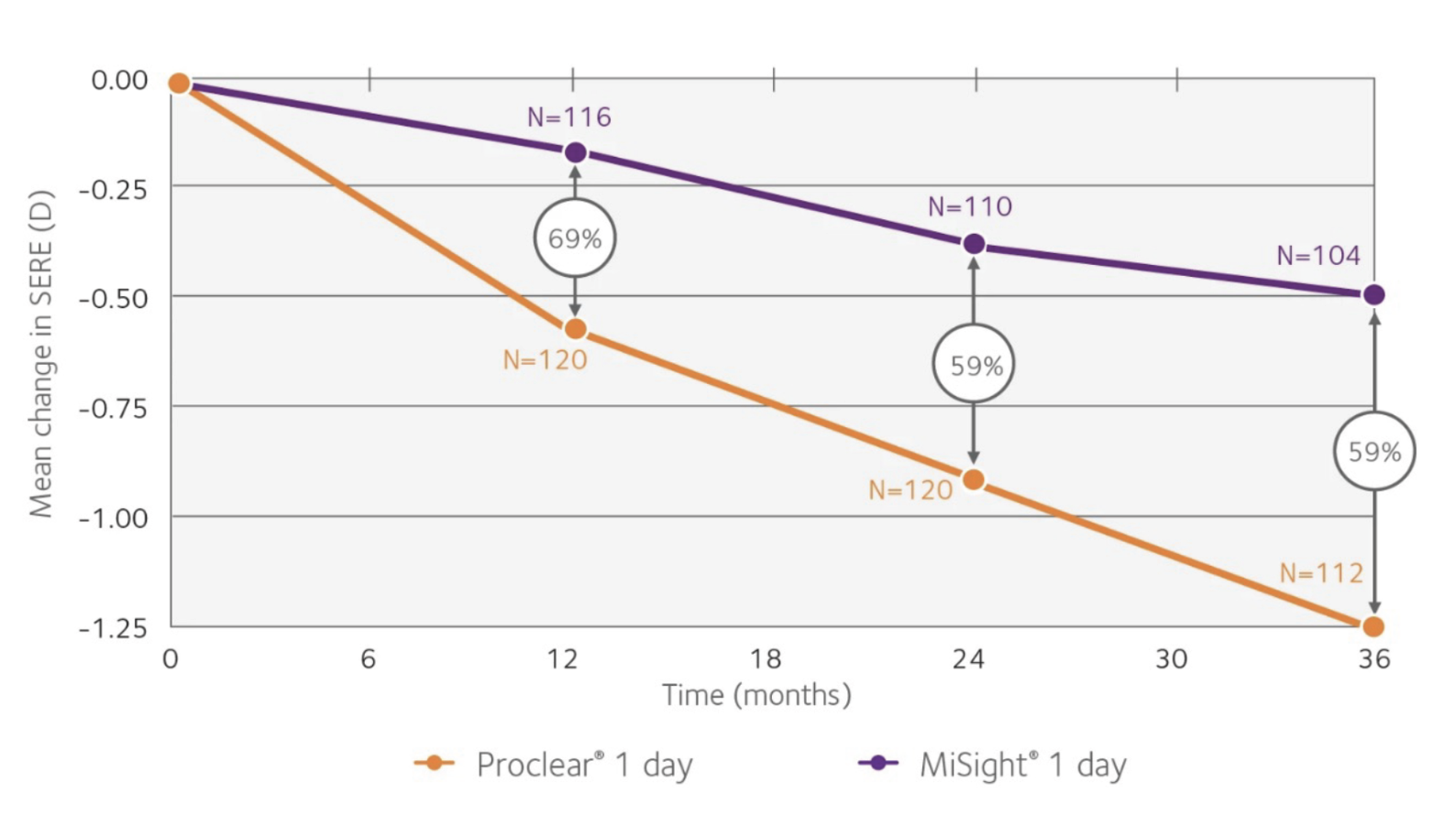 |
Fig. 6. A study of CooperVision’s MiSight 1 day lenses demonstrated a 59% reduction in myopia progression as well as a 52% reduction in axial length growth over a three-year period.29 Photo: CooperVision. Click image to enlarge. |
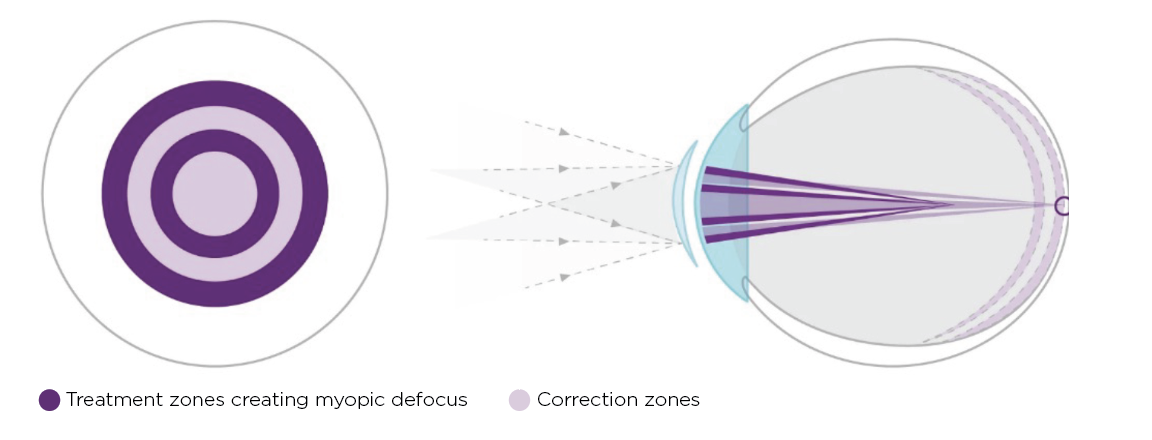 |
| Fig. 7. The MiSight 1 Day lens uses what the company calls “ActivControl technology,” consisting of two discrete rings with a +2.00D add (dark purple) to create myopic defocus on the retina.29 Photo: CooperVision. Click image to enlarge. |
• Proclear Multifocal, Proclear Multifocal XR and Proclear Multifocal Toric. The monthly replacement Proclear line of contacts is made from the first material FDA-approved for dry eye (omafilcon B) and became a central part of CooperVision’s offering when the company purchased Biocompatibles Eyecare in 2002. While this material has a high shear factor (tendency to rip or crack) and requires more careful handling, its high water content (62%) and zwitterionic nature that mimics cell membranes make this a comfortable lens with reduced depositing.9
The lenses come in seven aspheric center-near and center-distance adds (+1.00D to +4.00D in 0.50D steps) using the same “balanced progressive” feature as Biofinity multifocal and multifocal toric. Since it’s possible to fit both eyes with a D or an N lens, as well as a D in one and an N in the other, there are many lens combinations that can be tried based on the patient’s needs, blur tolerance and ability to accept modified monovision.26
Both the Proclear multifocal XR and multifocal toric are available in a -20.00D to +20.00D sphere power range and a steep and flat base curve. The multifocal toric is available in a -0.75D to-5.75D cylinder power range in 0.50D steps and in axis 5° to 180° in 5° steps.5 The large number of parameters and the ability to provide a distance-center lens makes fitting of these lenses flexible for patients who are new to multifocal CLs or have failed monovision or other multifocal designs.
J&J Vision Care
The original Acuvue bifocal consisted of five concentric rings alternating between distance and near, progressing from a center-distance zone (Figure 8).30
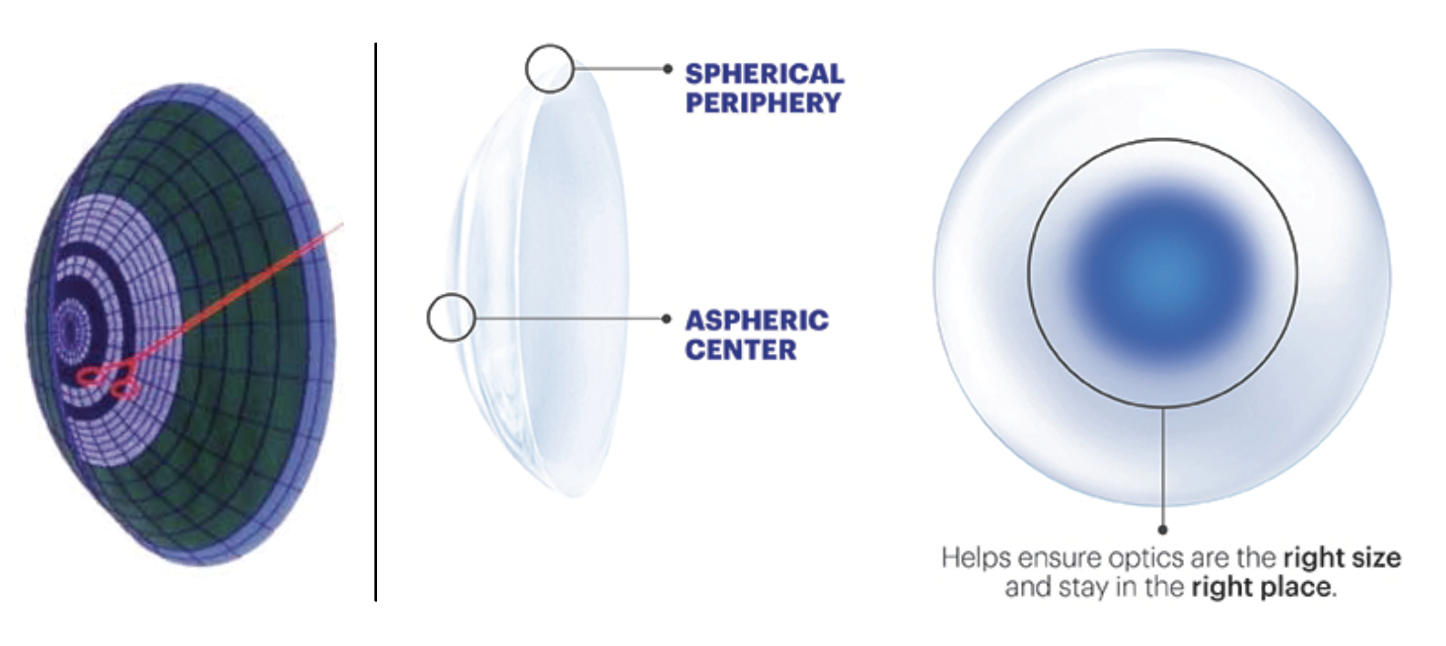 |
| Fig. 8. The original Acuvue bifocal CL (left) had five concentric rings to reduce glare in low lighting. The present design (right) is aspheric within the center but spherical in the periphery and the optic zone varies by the patient’s refractive power and age. Photo: J&J. Click image to enlarge. |
Acuvue Oasys for Presbyopia was another center-distance design with a more gradual transition between the distance and near zones; it was made of senofilcon, one of the most popular materials ever used in a contact lens. This multifocal lens was discontinued in 2022, and J&J Vision Care currently has three lenses on the market with an aspheric center-near design that is adjusted for pupil variation with the higher adds adjusted for age-related miosis as well as refractive error (Figure 8).31 We’ll discuss the details of each of these lens options below.
• 1-Day Acuvue Moist Multifocal. This HEMA (etafilcon A) daily disposable lens comes in three adds. The aspheric center-near zone is made smaller for higher adds and hyperopic corrections to correspond for decreases in the size of the pupil in hyperopes and as we age (Figure 9). The 1-Day Acuvue Moist Multifocal allows for optimal vision quality regardless of age and refractive error and is an excellent starting point for new multifocal wearers, especially latent hyperopes who are resistant to full-time spectacle wear and have progressed to need constant refractive correction for both distance and near.
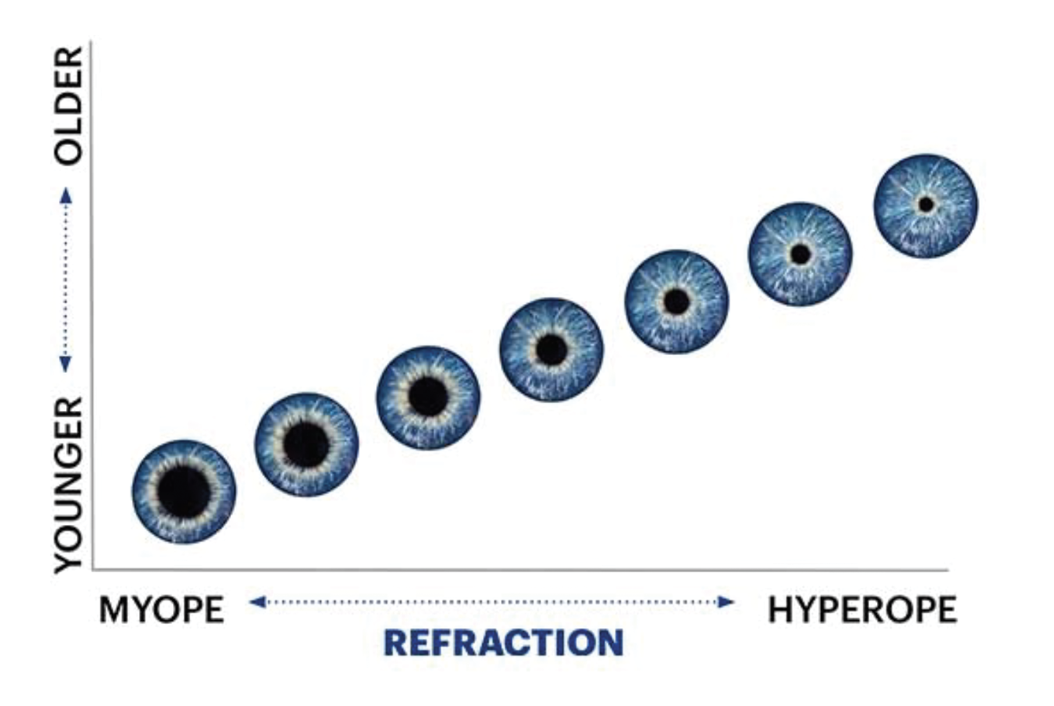 |
| Fig 9. J&J’s multifocal design adjusts pupil size not only by age (increasing add power) but also by refractive error. Photo: J&J. Click image to enlarge. |
• Acuvue Oasys Max 1-Day Multifocal. For enhanced near comfort, this daily disposable combines pupil optimization, SiHy material and a blue light filter (called OptiBlue). According to J&J Vision Care, the lens absorbs 60% of blue light, decreasing light scatter by up to 20%, halos by up to 30% and starbursts by up to 23% for sharper vision and better comfort.32 The increasing use of digital devices makes this a lens that could benefit all presbyopic contact lens wearers.
• Acuvue Oasys Multifocal. This biweekly SiHy lens (senofilcon A) comes in three adds with a pupil-optimized design, allowing for the comfort of the Acuvue Oasys material in a lens that adapts the near zone to the pupil size and refractive error. Good candidates for this lens are the large segment of CL wearers who are already pleased with Acuvue Oasys lenses and now require presbyopic correction.
Quarterly and Annual Replacement Multifocal LensesSeveral companies offer quarterly and annual replacement SCLs that come in a wide range of extended parameters and unique designs. ODs should have accounts with at least a few to be able to fit patients with more extreme refractive errors and other ocular parameters—e.g., excessively steep or flat corneas, a large or small cornea, irregular or large pupil—without need for referral to a specialty CL practice. • ABB Optical makes the Concise and Definitive multifocals, available in sphere and spherocylindrical powers with a sphere range from -20.00D to +20.00D, cylindrical power up to -8.00D in 1° axis increments, up to +3.50D add power in a center-near or center-distance design, optic zones from 8.0mm to 10.0mm, base curves from 7.5mm to 10.0mm and diameters from 13.0mm to 16.0mm.6,37 • California Optics makes the CO Soft 55 CL line, which includes the Crescent bifocal custom—a translating bifocal soft contact with an add power of up to +4.00D—as well as the custom bifocal and custom progressive multifocal. All three lenses come in sphere (-10.00D to +10.00D) and spherocylindrical powers (cylinder up to -5.00D) and have four base curves, add power up to +3.50D and adjustable optic zones for the custom bifocal.6 • GP Specialists (now part of CooperVision) makes the iSight CL line with available sphere powers from -25.00D to +25.00D, an add power of up to +4.00D, and customizable lens diameter (13.0mm to 15.5mm), base curve (8.0mm to 9.5mm) and optic zone (1.8mm to 3.5mm).6,38 • Metro Optics makes the MetroFocal, which is available in sphere (-12.00D to +12.00D) and spherocylindrical powers (cylinder up to -8.00D in 5° axis increments), comes in three different materials, six base curves (8.1 to 8.9) and up to +2.50D add power in a center-distance design.6,39 • SpecialEyes makes the 54 Bifocal and Multifocal lenses available in sphere (-25.00D to +25.00D) and spherocylindrical powers (sphere -20.00D to +20.00D and cylinder up to -8.00D in 1° axis increments), both with a highly customizable diameter (12.5mm to 16.0mm), base curve (6.9mm to 9.5mm), optic zone (8.0mm to 10.0mm) and center-near or center-distance design with add powers up to +4.00D in 0.10D increments.6,40 • United Contact Lens makes the UCL Bifocal in sphere (-20.00D to +20.00D) and spherocylindrical powers (cylinder up to -3.00D), four base curves (8.3 to 9.2), six sag diameters (1.7mm to 3.2mm) and add powers up to +3.50D. The UCL multifocal is available in sphere (-20.00D to +20.00D) and spherocylindrical powers (cylinder up to -3.00D), three base curves (8.3mm to 9.0mm), variable optic zones (8.0mm to 10.0mm for the sphere only) and add powers up to +3.00D.6 • X-Cel Specialty Contacts makes the Horizon Bi-con Bifocal and Horizon Progressive, two concentric optics center-near lenses available for spherical and toric correction in three materials, two diameters, base curves from 8.0mm to 9.2mm, a bifocal add from as low as +0.50D to +4.00D (for the bi-con bifocal) and a sphere power range of +20.00D to -20.00D. The lenses are recommended to be fit with a 3mm optical zone for the dominant eye and a 2.5mm zone for the non-dominant eye.6,41 |
Visioneering Technologies Inc (VTI)
While a much smaller company than the “big four,” VTI offers one multifocal—NaturalVue Enhanced multifocal—that features a virtual pinhole design to increase the range of clear vision. For patients who need a high add, this lens may be a contender. This HEMA daily disposable (etafilcon A) boasts center-distance optics surrounded by a rapid progressive increase in plus power to an equivalent add of +3.00D. It generates peripheral defocus like the MiSight 1 Day and is currently being studied for myopia management applications.33 The absence of a central spherical distance zone generates a virtual pinhole aperture to create nearly twice the range of clear vision as multifocal lenses that do have spherical zones.34 The NaturalVue multifocal was launched in 2015 and recently improved with what VTI calls a “TripleTear lubrication system” and an ultra-tapered edge for better comfort.
Menicon America
This company is known for its innovative flat blister pack as well as high Dk materials. It has combined these strengths with the Miru 1 day UpSide multifocal. This daily disposable high water content silicone hydrogel (midafilcon A, 91Dk/t, 56% water) multifocal CL has a center-near aspheric design with two add powers.
The innovative “smart touch” packaging allows for a guaranteed correct application that avoids contact of the fingers with the inside of the lens.35 Patients with reduced finger dexterity or those who are unable to tell when the lens is inserted inside-out may benefit from this unique packaging design.
Another multifocal SCL offered by Menicon—Miru 1 month multifocal—is an ultra-high Dk silicone hydrogel (asmofilcon A, 161Dk/t, 40% water) one-month replacement lens available in two center-near aspheric add powers. The unique manufacturing process involves silicone polymerization containing a hydrophilic monomer that produces a smooth surface with nanometer precision, optimizing visual clarity, wettability and resistance to bacterial adherence.35,36
Conclusion
After reading about the sheer number of brands and parameters that are available for patients interested in wearing a multifocal SCL, I hope you impress your next hard-to-fit presbyope or astigmat by successfully matching them with one of the many multifocal soft contact lens “players” available.
Editor’s note: Look for another article in the Jan/Feb 2024 issue by Dr. Stokkermans discussing GP multifocals.
Dr. Stokkermans is an associate professor at the Case Western Reserve School of Medicine, director of optometric services at University Hospitals Cleveland Medical Center and an adjunct faculty member of five optometry schools in the US. He is a fellow of the American Academy of Optometry, the chief editor of Optometry Advanced Medical Care at www.statpearls.com and a medical writer and reviewer at www.allaboutvision.com. He has participated in over 30 contact lens trials. He discloses financial relationships with BioTissue and Tarsus.
1. Richdale K, Mitchell GLM, Zadnik K. Comparison of multifocal monovision soft contact lens corrections in patients with low-astigmatic presbyopia. Optom Vis Sci. 2006;83(5):266-73. 2. Benoit DP. Aspheric multifocal gas permeable CLs: fitting, evaluation, and problem-solving. Contact Lens Spectrum. September 1, 2017. 3. Proclear multifocal toric. Coopervision. coopervision.com/practitioner/our-products/proclear-family/proclear-multifocal-toric. Accessed October 10, 2023. 4. Ultra monthly contacts. Bausch + Lomb. bausch.com/our-products/contact-lenses/lenses-for-astigmatism/bausch-lomb-ultra-multifocal-for-astigmatism. Accessed October 10, 2023. 5. Annual contact lenses and lens care guide. RCCL. July/August 2023. 6. Grant NJ, Fujimoto MJ, Caroline PJ, Norman CW. History of contact lenses. Contact Lens Spectrum November 1, 2021. 7. Dumbleton K, Palombi J. Soft multifocal contact lenses: a review. Contact Lens Spectrum. June 1, 2022. 8. Nichols JJ, Fisher D. Contact lenses 2022. Contact Lens Spectrum. January 1, 2023. 9. Bauman E, et al. Material effect on multifocal contact lens fitting of lenses of the same optical design with the same fitting guide. Presented at the British Contact Lens Association Clinical Conference & Exhibition, June 9-11, 2017. Liverpool, UK. 10. Willcox M. Biocompatibility: buzzword or breakthrough? RCCL. May 15, 2013. 11. SynergEyes iD multifocal EDOF. SynergEyes. synergeyes.com/professional/synergeyes-id-edof-product-page. Accessed October 10, 2023. 12. Pence N. Contact lens design & materials: continuous improvement principles in a soft multifocal. Contact Lens Spectrum. December 1, 2013. 13. B+L launches revive custom soft contact lenses. Review of Ophthalmology. August 10, 2022. 14. Astera multifocal toric soft lens. Bausch SVP. bauschsvp.com/globalassets/pdf/packageinserts/surgical/astera-sales-aid.pdf. Accessed October 10, 2023. 15. Kingston AC, Cox IG. Predicting through-focus visual acuity with the eye’s natural aberrations. Optom Vis Sci. 2013;90(10):1111-8. 16. Revive custom soft lenses. Bausch SVP. bauschsvp.com/lenses/revive-custom-soft-lenses. Accessed October 10, 2023. 17. Dutta D, Cole N, Willcox M. Factors influencing bacterial adhesion to contact lenses. Mol Vis. 2012;18:14-21. 18. Rah M,Saxon J, Reindel WT. Real-world performance captures the presbyopic opportunity. Contact Lens Spectrum. October 1, 2016. 19. Bausch + Lomb ultra multifocal for astigmatism monthly toric contact lenses. Bausch + Lomb. ecp.bauschcontactlenses.com/products/ultra-monthly/multifocal-for-astigmatism. Accessed October 10, 2023. 20. Biotrue ONEday surface active technology. Bausch + Lomb. ecp.bauschcontactlenses.com/education-center/biotrue-oneday-surface-active-technology. Accessed October 10, 2023. 21. Jones L, Downie LE, Korb D, et al. TFOS DEWS II management and therapy report. Ocul Surf. 2017;15(3):575-628. 22. Infuse one-day multifocal contact lenses. Bausch + Lomb. ecp.bauschcontactlenses.com/products/infuse-one-day/multifocal. Accessed October 10, 2023. 23. Biofinity multifocal. CooperVision. coopervision.com/contact-lenses/biofinity-multifocal. Accessed October 10, 2023. 24. Dumbleton K, Woods CA, Jones LW, Fonn D. The impact of contemporary contact lenses on contact lens discontinuation. Eye Contact Lens. 2013;39:93-9. 25. Clariti 1 day multifocal. CooperVision. coopervision.com/contact-lenses/clariti-1-day-multifocal. Accessed October 10, 2023. 26. Balanced progressive technology. CooperVision. coopervision.com/practitioner/our-products/contact-lens-technology/balanced-progressive-technology. Accessed October 10, 2023. 27. Binocular progressive system. CooperVision. coopervision.com/practitioner/our-products/contact-lens-technology/binocular-progressive-system. Accessed October 10, 2023. 28. Ruiz-Pomeda A, Pérez-Sánchez B, Valls I, et al. MiSight Assessment Study Spain (MASS). A 2-year randomized clinical trial. Graefes Arch Clin Exp Ophthalmol. 2018;256(5):1011-21. 29. MiSight 1 day. CooperVision. coopervision.ca/practitioner/our-products/misight/misight-1-day. Accessed October 10, 2023. 30. Hansen D. Multifocal contact lenses- the next generation. Contact Lens Spectrum. November 1, 2002. 31. Acuvue pupil optimized design. Johnson and Johnson Vision. jnjvisionpro.ca/education-centre/pupil-optimized-design. Accessed October 10, 2023. 32. Renzi-Hammond LM, Buch J, Xu J, Hammond BR. Reduction of glare discomfort and photostress recovery time through the use of a high-energy visible-filtering contact lens. Eye Contact Lens. 2022;1;48(12):516-20. 33. Progressive myopia treatment evaluation for NaturalVue multifocal contact lens trial (PROTECT). ClinicalTrials.gov. Updated October 6, 2022. clinicaltrials.gov/ct2/show/NCT05159765. Accessed October 10, 2023. 34. Lens design. Visioneering Technologies, Inc. vtivision.com/practitioner/lens-design. Accessed October 10, 2023. 35. Contact lenses. Menicon America. meniconamerica.com/professional/products/soft-lenses. Accessed October 10, 2023. 36. Vijay AK, Zhu H, Ozkan J, et al. Bacterial adhesion to unworn and worn silicone hydrogel lenses. Optom Vis Sci. 2012;89(8):1095-106. 37. Duette progressive. SynergEyes. synergeyes.com/professional/duette/duette-progressive. Accessed October 10, 2023. 38. Duette multifocal. SynergEyes. synergeyes.com/professional/duette/duette-multifocal. Accessed October 10, 2023. 39. Davis RL, Scwartz M. Seeing multifocal optics more clearly. RCCL. May/June 2021. 40. Boston multivision. Contact Lens Compendium. compendium.contactlensupdate.com/us/contact_lens/view/614. Accessed October 10, 2023. 41. Blanchard products/one fit. CooperVision. blanchardlab.com/products/onefit. Accessed October 10, 2023. |


